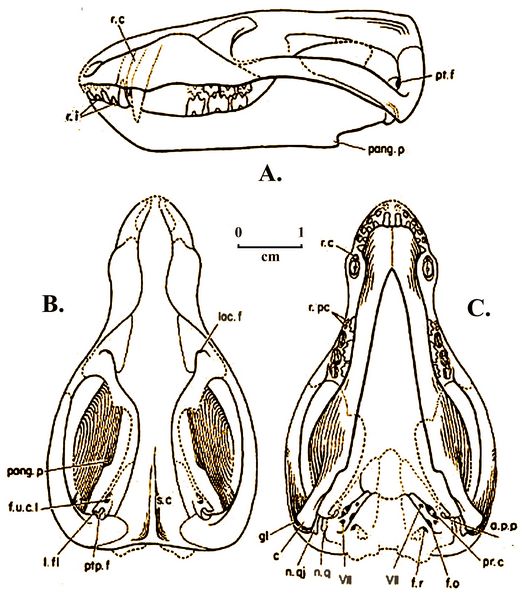Athena Review Image Archive ™
Sinoconodon rigneyi skull

Skull of Sinoconodon rigneyi (after Patterson and Olson 1961 )
Sinoconodon rigneyi, an advanced cynodont and the most basal of the known mammaliaforms, dates from the Early Jurassic, and was found in Yunnan Province in southern China. The genus name Sinoconodon derives from Sino- "Chinese," and -conodon "tooth." The type species S. rigneyi was discovered at Tati in the Lufeng Formation in Yunnan Province, representing the Early Jurassic, Sinemurian stage, dating from 196.5 to 189.6 Mya. The holotype (IVPP V 6747) includes the anterior part of the skull and the lower jaws, and post-cranial fragments from several individuals (Patterson and Olson 1961).
A second species from the same formation, Sinoconodon yangi, was recovered as a skull from south of Dahuangtian Village. A third species, S .Changchiawaensis, is based on a skull from Zhangjiawa in the Lufeng Formation.
Sinocodon shows a unique combination of reptilian and mammalian features. It
possessed a secondarily evolved jaw joint between the dentary and the
squamosal bones, which had replaced the primitive reptilian joint
between the articular and quadrate bones. It retained the double jaw
joint seen in other advanced Cyndonts. Here, however, while the
reptilian jaw joint was still present (though tiny), the mammalian jaw
joint was stronger, with a large dentary condyle fitting into a
distinct fossa on the squamosal. This refinement of the jaw joint is
the main criterion for identifying Sinoconodon as a Mammaliaform.
Its eye socket was now fully mammalian, with a closed medial wall. It
has an expanded hindbrain, one of the key traits of early mammals.
Although the animal appears closely related to the more mammalian
Morganucodon, it differed substantially from it in in its dental and
growth habits. Like mammals, it had permanent cheekteeth or molars. At
the same time, like the reptiles, Sinocodon was polyphyodont, replacing
many of its teeth throughout its lifetime, and it seems to have grown
slowly but continuously until its death. Even the smallest known
individuals had already began the teething cycle in their front
teeth.
The skull length of Sinocodon was 22-62 mm, and its body weight estimated from 13 to 517 grams. Regarding the development of the middle ear, a key early mammalian trait, S. rigneyi had three petrosal bones, but only the stapes was inside the ear. The incus and malleus still formed part of a multi-boned lower jaw.
Sinoconodon is regarded as the most basal of the mammaliaforms, and the sister−taxon to a clade that includes Morganucodon and the living mammals ( Luo et al 2002). Fossils of Sinoconodon rigneyi, discoverd by Patterson & Olson (1961), include a partial skull and post-cranial fragments from several individuals. It shows a unique combination of reptilian and mammalian features, including a double jaw joint seen in other advanced cyndonts. This comprised a mammalian jaw joint between the dentary and the squamosal bones, which had replaced the primitive reptilian joint between the articular and quadrate bones, although a tiny reptilian jaw joint was still present..
References:
Patterson, B. and E. C. Olson. 1961. A triconodont mammal from the Triassic of Yunnan. Int. Colloq. on Evolution of Lower and Non Specialized Mammals. Koninklijke Vlaamse Academir voor Wetenschappen; Letteren en Schone Kunsten can Belgie, pp 129-191.
Crompton, A.W. and A. L. Sun 1985. Cranial structure and relationships of the Liassic mammal Sinoconodon. Zoological Journal of Linnean Society 85, pp. 99-119.
Kielan-Jaworowska, Z, Luo, Z-X, Cifelli, R.L 2004. Mammals from the Age of Dinosaurs. Columbia University Press. Chapter 4.
Young, C-C. 1982. Two primitive mammals from Lufeng, Yunnan. Selected Works of Yang Zhungjian. Science Press, Beijing, pp. 21-25.
Copyright © 1996-2020 Rust Family Foundation (All Rights Reserved).